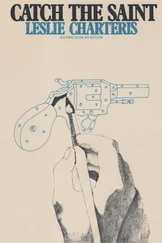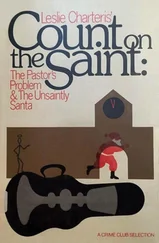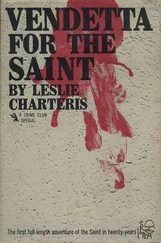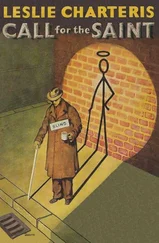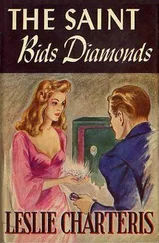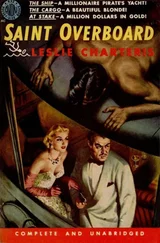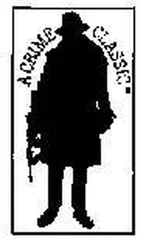By taking sight bearings on a couple of trips inside the grounds, he made sure of being able to locate his handiwork again without hesitation, and then returned to the road outside as he had come, after hiding the haversack and some of its equipment under a bush beside the fence.
A few minutes later he was outside the main entrance.
The gates were of heavy wrought iron, massively bolted and locked. Beside a small brass plate bearing the words
THE PHYSICAL EFFICIENCY CENTRE
there was a bell-push. He leant on it for a few seconds. He could see a light in the gate lodge, and presently two athletic-looking men emerged. They were dressed alike, in dark blue denims and black roll-neck pullovers. One man was carrying a powerful torch, which he shone full in the Saint’s face. The other man kept one hand behind his back, and it didn’t take a clairvoyant to guess what might be in it.
“Name?” demanded a surly voice from behind the lantern.
“Simon Templar,” said the Saint, in Gascott’s rasping voice.
It was an outrageous flourish of the kind he couldn’t resist. And as a variant of the effective technique of deception by the obvious, it had a potential practical function too. A George Gascott who had announced himself under another name, especially if by doing so he was making the ridiculous claim to be the Saint, was less likely to be suspected at some point of being actually a phoney.
The surly voice said: “Come again?”
“Simon Templar,” he repeated. “Tell Rockham I’ve come to sew him a few mailbags.”
There was silence for a few moments as the two guards absorbed this revelation. Their impulse, he knew, was to reject it outright — which might have been unfortunate for him, since their method of rejection would probably have contained no milk of human kindness. But he could see them wavering with uncertainty.
The spokesman spoke again.
“Wait there.”
He went back into the gate lodge, leaving his partner standing on silent watch, and Simon amused himself by imagining the exact course of the conversation on the phone with Rockham, who he was confident would add it up in two seconds flat.
And he was right. A minute later the character with the torch re-emerged. He had a jangling bunch of keys in the other hand.
“Mr Gascott, is it?” he said with rather less surliness and rather more respect in his voice.
Gascott had an arrogant way of half-inclining his head in a confirming gesture that was barely on the affirmative side of indifference. The Saint produced just that condescending wag of the head now, and to perfection, so that any impulse to amiable conversation that might have been about to burgeon in the guard’s tender breast was nipped firmly in the bud till after he had opened the heavy gates enough to let the Saint through, and had slammed the solid bolts and padlocks back into place.
Then the gatekeeper said: “There’ll be a jeep for you in a minute”; and in about that time Simon heard the note of an engine puttering through the mist, and saw the twin cones of light sweeping down the long curve of driveway from the main buildings.
He climbed into the jeep beside the driver; the man nodded to him and grunted a greeting. He was dressed like the two guards, and he had a revolver on the parcel shelf, within easy reach of his right hand.
As the jeep backed and turned, Simon automatically registered and memorised the layout of the front entrance and the gatehouse and driveway. Almost as soon as they had moved off again in forward gear, they passed through a gap which was probably the one single breach in the whole length of the engirdling electrified fence — or had been, until his preparatory foray over the wall.
The main buildings were an architectural hotchpotch spanning two and a half centuries. The original Kyleham House had been one of the county’s principal manor houses. Successive owners, presumably increasingly plutocratic and insensitive, had added wing after unbefitting wing, and piled annexe upon incongruous annexe; and during its days as a boarding college, still more extensions and new outbuildings had further compounded the desecration, so that the whole effect was almost of a random assemblage that a child might have made with a lot of dull-coloured playbricks of ill-assorted shapes and sizes.
At the centre of the sprawl of buildings, embedded in the larger structure that had grown by accretion, was the original manor house, preserved virtually unaltered. Its facade was elegant, white-painted, colonnaded. The jeep stopped in front of it, and the driver led Simon in through the main door and up a curved staircase that must have been designed with the house itself.
The driver opened a door leading off the landing and announced laconically: “This is him.”
He went away, and the Saint saw that he had been shown into a short of anteroom. There was a door at the far end — leading, he guessed, to Rockham’s office — and there were two men seated in the room. They were dressed like the others except that their pullovers were grey.
The two faces that turned towards him belonged to the men he would shortly know as Lembick and Cawber; and if those faces were lit up with open-hearted friendliness it must have been by bulbs of micro-wattage.
“Good evening, boys,” the Saint rasped. He held up a restraining hand to stem the non-existent flow of conversation. “Wait. Don’t tell me. Let me guess. That must be the Head’s office.” He pointed to the farther door. “And you” — he beamed at them — “you must be a couple of naughty boys waiting for six of the best. You really must stop this smoking in the lavatory, you know.”
He laughed in that hollow way; and the chunky transatlantic half of the welcoming party lumbered off his chair and looked at him aslant.
“So you’re Gascott, huh? And you said you was Simon Templar — the Saint! A comedian. You notice that, Lembick?” He kept his eyes fixed on the Saint while addressing the other man. “You notice that? He’s a funny-man.”
Simon put a hand to his mouth, yawned elaborately, and gazed idly around at the ceiling, while the other half of the welcoming party, which rapidly established itself as Caledonian, said:
“We’ll have some fun with him then — won’t we, Cawber?” There was a hard edge of sadistic anticipation in the crag-faced Lembick’s voice. To Simon he said fiercely: “Ye’ll train under us!”
“Och, laddie!” Simon exclaimed in an apalling parody of Lembick’s accent. “I cannae wait! But what d’ye have in mind tae teach me? Wuid it be tossing the caber? Or wuid ye prefairrr tae instrrruct me in the proper care and feeding of the domestic sporrran?”
Abruptly he strode to Rockham’s door; he knocked once and was on his way in even before the monosyllable “Come!” had snapped its way through the air, and before Lembick and Cawber had realised what was happening. They followed indignantly in his wake. “Boss — he just barged right past us...” Cawber trailed off, glaring malevolent fury at the Saint; and Rockham waved him down placatingly.
“Never mind, Cawber. Mister Gascott’s a very positive personality. That’s why I wanted him to join us.”
The pale blue eyes appraised the Saint in this new setting; and the Saint returned the compliment, looking at Rockham and Rockham’s office with a frank evaluative openness that betokened complete and calm self-confidence. Behind him, in contrast, Lembick and Cawber shifted awkwardly on their feet, exactly like the errant school-boys which he had twitted them for resembling.
Rockham’s office might have been — perhaps had been — designed to make men like Lembick and Cawber feel acutely ill at ease. A luxurious thick-piled carpet in a dark classical design blended perfectly with quietly decorous furniture — the Saint guessed eighteenth century. Against this restrained background, the effect of a huge shock-colour abstract on one wall was electrifying.
Читать дальше

